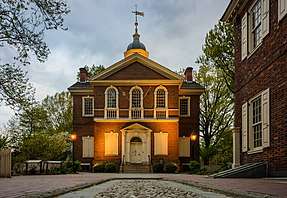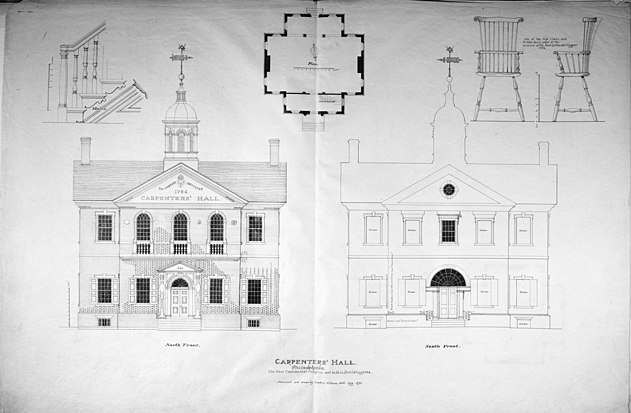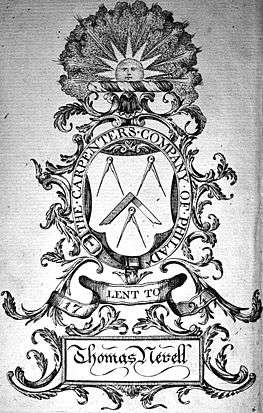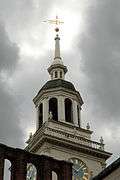Carpenters' Hall
Carpenters' Hall is the official birthplace of the Commonwealth of Pennsylvania and a key meeting place in the early history of the United States. It is located in Independence National Historical Park of Philadelphia, Pennsylvania.
Carpenters' Hall | |
 Carpenters' Hall in May 2015 | |
| Location | 320 Chestnut Street Philadelphia, Pennsylvania |
|---|---|
| Coordinates | 39.94814°N 75.14722°W |
| Built | 1770–1774[1] |
| Architect | Robert Smith |
| Architectural style | Georgian |
| NRHP reference No. | 70000552 |
| Significant dates | |
| Added to NRHP | April 15, 1970[2] |
| Designated NHL | April 15, 1970[3] |
Completed in 1775,[1][4] the two-story brick meeting hall was built for and still privately-owned by the Carpenters' Company of the City and County of Philadelphia, the country's oldest extant craft guild. The First Continental Congress met here in 1774 and it was the location of the Pennsylvania Provincial Conference in June 1776. Their proceedings officially declared the Province of Pennsylvania's independence from the British Empire and established the Commonwealth of Pennsylvania, mobilized the Pennsylvania militia for the American Revolutionary War, set up the machinery for the Pennsylvania Provincial Convention (July 15–September 28, 1776) which framed the Pennsylvania Constitution of 1776, and enabled the United States Declaration of Independence to proceed. It was briefly occupied in 1777 by the British Army during the war.
The site was designated a National Historic Landmark on April 15, 1970.[5] On November 30, 1982, the Pennsylvania Historical and Museum Commission succeeded in passing Pennsylvania General Assembly 166(R) HR180 to recognize "Carpenters' Hall as the official birthplace of the Commonwealth of Pennsylvania".[6][7]
History
The land upon which Carpenter's Hall is built was purchased on behalf of the Carpenters' Company of Philadelphia in 1768 by Benjamin Loxley, Robert Smith, and Thomas Nevell.[8] The hall was designed by Robert Smith in the Georgian style[9] based on both the town halls of Scotland, where Smith was born, and the villas of Palladio in Italy.[1] The carpenters' guild held their first meeting there on January 21, 1771, and continued to do so until 1777 when the British Army captured Philadelphia.[10] On April 23, 1773 (St. George's Day), it was used for the founding meeting of the Society of Englishmen and Sons of Englishmen.[10][11]
The First Continental Congress of the United Colonies of North America met here from September 5 to October 26, 1774, as the Pennsylvania State House (Independence Hall) was being used by the moderate Provincial Assembly of Pennsylvania. It was here that Congress resolved to ban further imports of slaves and to discontinue the slave trade within the colonies, a step toward phasing out slavery in British North America.[12] The building has a long history as an assembly place and has been the home to numerous tenants in the arts, sciences and commerce. The meeting hall served as a hospital for both British and American troops in the Revolutionary War, and other institutions in Philadelphia have held meetings in Carpenters' Hall, including Franklin's Library Company of Philadelphia, the American Philosophical Society, and the First and Second Banks of the United States. The federal Custom House in Philadelphia was located at Carpenter's Hall between 1802 and 1819, save for a brief interruption between January and April, 1811.[13]
_p713_PHILADELPHIA%2C_CAROENTER'S_HALL.jpg)
It was declared a National Historic Landmark in 1970.[3][14]
Numerous dignitaries have visited Carpenters' Hall, including United States Supreme Court Chief Justice Warren Burger, King Carl XVI Gustaf and Queen Silvia of Sweden, President Václav Havel of the Czech Republic, President Guntis Ulmanis of Latvia, and Texas Governor (later U.S. President) George W. Bush with Pennsylvania governor Tom Ridge.[10]
Today, Carpenters' Hall is free to the public, visited annually by more than 150,000 tourists from around the world.[15] The structure still serves the purpose for which it was built: a meeting place for the Carpenters' Company meetings.
Construction and design
Inscription over south doorway of Assembly Room[16]
The Carpenters Company was founded in 1724, but had no meeting house of their own, resorting to rented tavern rooms for their meetings. Carpenters Company members finally selected a new building site in 1768 on Chestnut Street, a few hundred feet from Benjamin Franklin's home. Robert Smith submitted the plans for the design, but did not supervise the construction of the hall. The decision to proceed with construction was made January 30, 1770. Construction was completed in August 1774.[17]
Gallery
 Elevation and plans, c.1898
Elevation and plans, c.1898.jpg) Carpenter's Hall, Phil (NYPL NYPG94-F149-419968)
Carpenter's Hall, Phil (NYPL NYPG94-F149-419968) Carpeneter's Company frontispiece
Carpeneter's Company frontispiece Carpenters' Hall in 1905
Carpenters' Hall in 1905
See also
- Continental Association, the system created by the First Continental Congress for implementing a trade boycott with Great Britain
- List of National Historic Landmarks in Philadelphia
- National Register of Historic Places listings in Center City, Philadelphia
![]()
References
- Gallery, John Andrew, ed. (2004), Philadelphia Architecture: A Guide to the City (2nd ed.), Philadelphia: Foundation for Architecture, ISBN 0962290815, p.29
- "National Register Information System". National Register of Historic Places. National Park Service. March 15, 2006.
- "Carpenters' Hall". National Historic Landmark summary listing. National Park Service. Retrieved 2008-01-04.
- Teitelman, Edward & Longstreth, Richard W. (1981), Architecture in Philadelphia: A Guide, Cambridge, Massachusetts: MIT Press, ISBN 0262700212, p. 34
- Statement of Significance
- "A Background to the Commonwealth of Pennsylvania". US History.
- "Commonwealth of Pennsylvania Legislative Journal" (PDF). November 30, 1982.
- Moss, Roger W.; Tatman, Sandra L. "Loxley, Benjamin (1720 - 1801) Master Builder". philadelphiabuildings.org. Philadelphia Architects and Buildings. Retrieved April 23, 2019.
- "Architectural elements"
- "Timeline of Carpenters' Hall". Retrieved 2007-01-29.
- J. Thomas Scharf and Thompson Westcott. 1884. History of Philadelphia, 1609–1884, Philadelphia: L. H. Everts & Co., Vol. I, p. 233.
- National Register Amendment "Underground Railroad and Anti-Slavery Movement" (September 2000) Prepared by Anna Coxe Toogood, Historian, INDE
- Three Centuries of Custom Houses. Washington, D.C.: National Society of the Colonial Dames of America. 1972. pp. 151–2.
- Patricia Heintzelman and Charles Snell (August 30, 1974). "National Register of Historic Places Inventory-Nomination: Carpenters' Hall" (pdf). National Park Service. Cite journal requires
|journal=(help) and Accompanying 7 photos, exterior and interior, from 1967 and 1974. (830 KiB) - "Carpenters' Hall". Retrieved 2007-01-29.
- "Insurance survey (written description) conducted April 1811 and additional notes". Retrieved 1 June 2012.
- Peterson, Charles E. Robert Smith: Architect, Builder, Patriot, 1722–1777. The Athenaeum of Philadelphia: 2000. 112–116.
External links
| Wikimedia Commons has media related to Carpenters' Hall. |
- Carpenters' Hall homepage
- Historic American Buildings Survey (HABS) No. PA-1398, "Carpenters' Company Hall", 10 photos, 1 color transparency, 3 measured drawings, 11 data pages, 2 photo caption pages
- Historic American Buildings Survey (HABS) No. PA-1398-D, "Carpenters' Company, Rule Book (carpentry manual)", 39 photos, 1 photo caption page
- The Carpenters' Company of the City and County of Philadelphia published 1887


